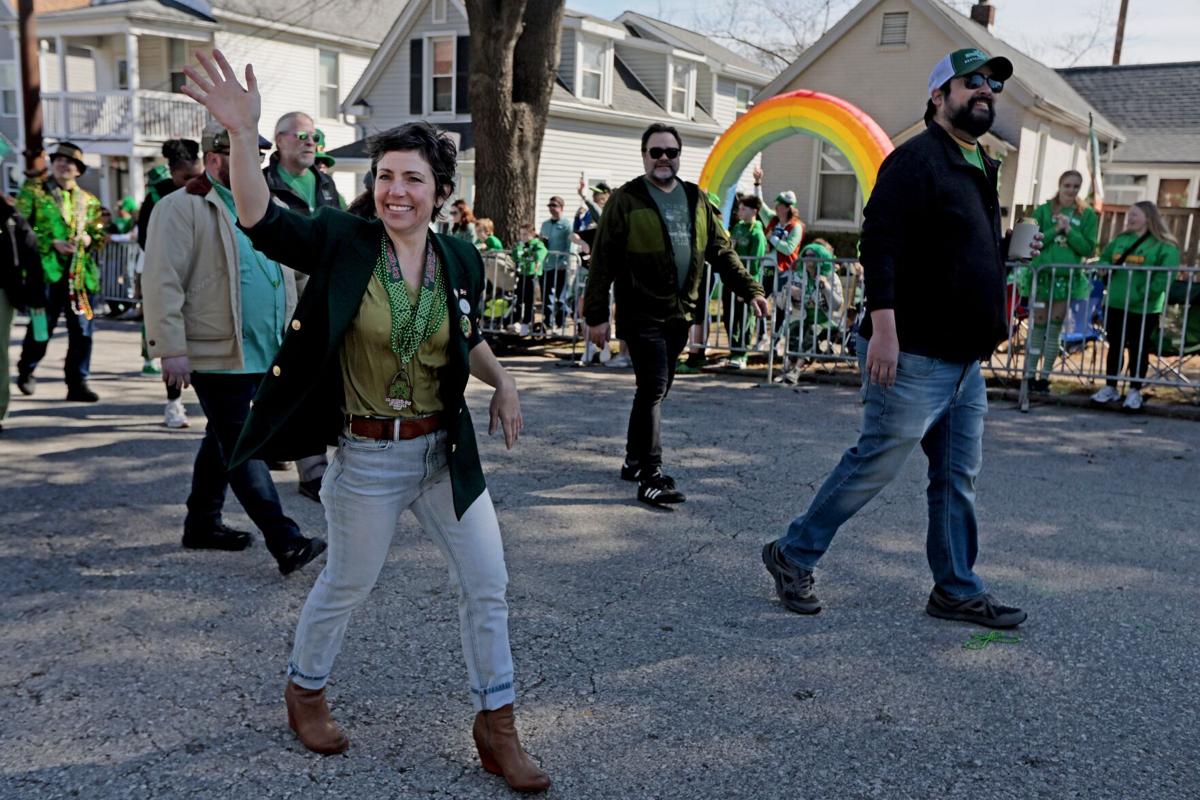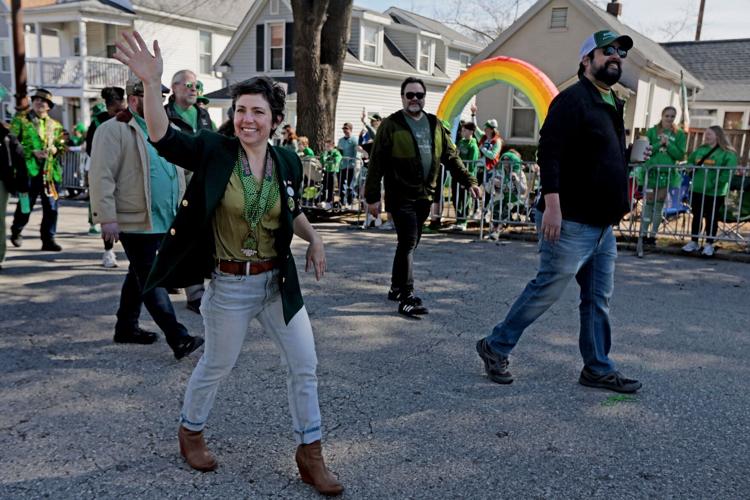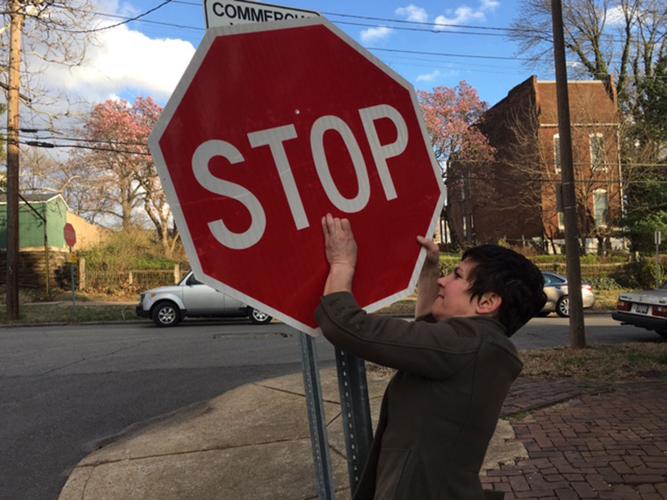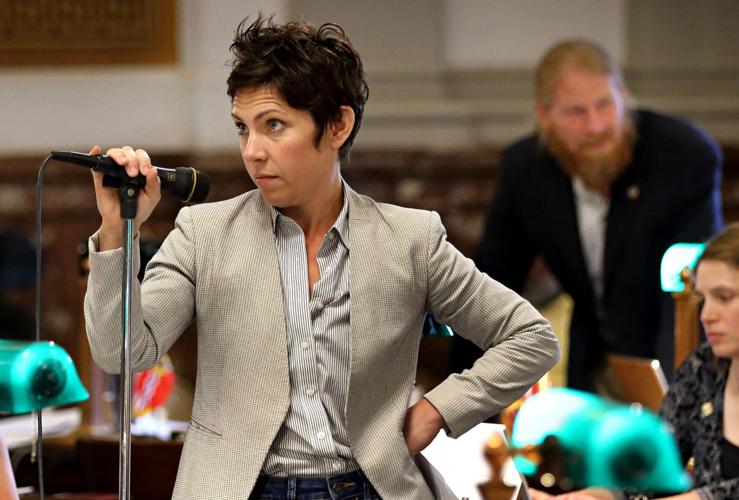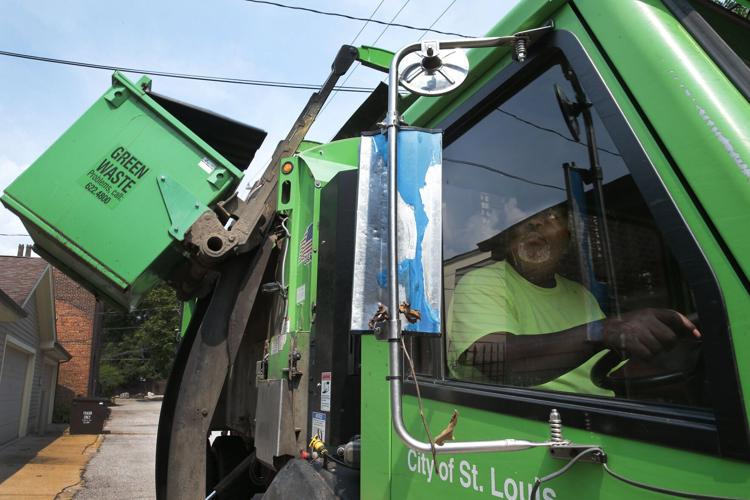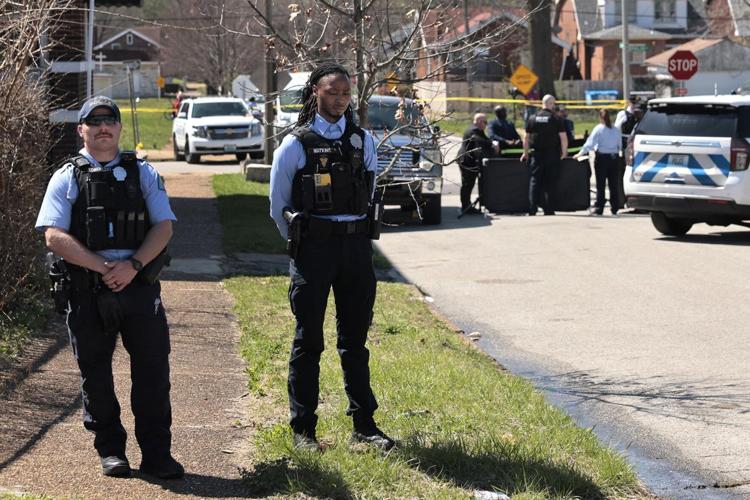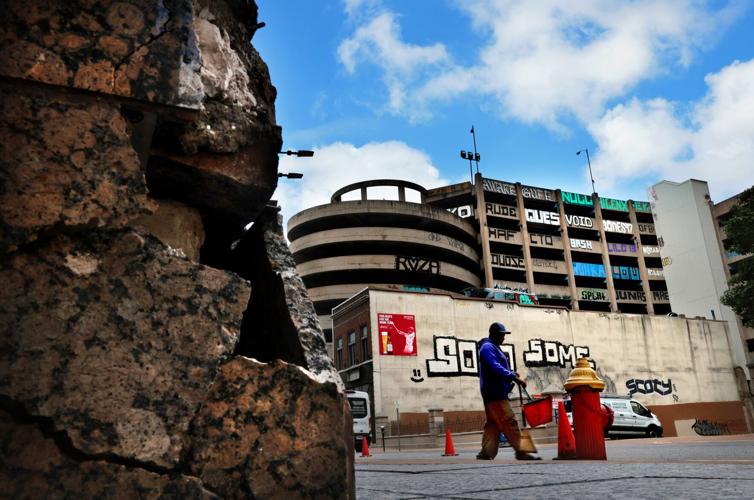ST. LOUIS ÔÇö For most of an hour last weekend, Alderwoman Cara Spencer told a roomful of people at a candidate forum about her vision for the city.
It involved a lot of change: The city would be safer, bigger, stronger. More efficient, more functional, more populous.
Mayor Tishaura O. Jones, in her rebuttal, scoffed.
ÔÇťItÔÇÖs easy to criticize something,ÔÇŁ Jones said, ÔÇťwhen youÔÇÖve never run it.ÔÇŁ
Spencer, over the last 10 years, has made her name in city politics as a critic. SheÔÇÖs fought against cash for sports teams, payday lenders and airport privatization. Once, when the city refused to put a stop sign near a school in her ward, she got a sledgehammer and did it herself.
People are also reading…
She ran for mayor against Jones four years ago, promised change citywide, and lost by a few percentage points. And sheÔÇÖs done it again this campaign, pledging to fix a long list of the cityÔÇÖs biggest problems: Unreliable trash pickup. Broken streets. Continued population loss. The persistent perception that the city is not safe.
This time, voters have bought in. Spencer notched a 35-point win over Jones in the March primary and is the favorite in the April 8 run-off.
But, if she wins, the promises will become tasks. Residents will expect results.
Even Spencer acknowledges it will be tough.
City leaders have tried and failed to reverse population decline since the 1950s. Ëú╠Ď╩ËĂÁÔÇÖ struggle to hire the workers necessary to pick up trash and pave streets is challenging cities across the country. And public safety is about to get a lot more complicated, with the state taking over the police department.
ÔÇťThere are moments where I think, ÔÇśI have made a lot of promises,ÔÇÖÔÇŁ Spencer said in an interview Thursday.
But she said she gets inspired looking at the Eads Bridge. The plan to build it was daring: JamesÔÇÖ Eads design was novel. Rival engineers said it couldnÔÇÖt be done. Steamboat owners and the local ferry monopoly didnÔÇÖt want it built. But Eads did it anyway.
Big things like that can still be done here, she said, with the right team in place, a big coalition and a lot of hard work.
ÔÇťI know itÔÇÖs hokey, but I truly believe in St Louis,ÔÇŁ she said. ÔÇťSomebody has got to pull us out of decline.ÔÇŁ
People who know Ëú╠Ď╩ËĂÁ politics and have worked in city government, from professors to contractors to former officials, agree with SpencerÔÇÖs ambition. Some even think she has a shot at success.
But theyÔÇÖve also heard it all before.
ÔÇťIÔÇÖve been here since the 1970s,ÔÇŁ said Ken Warren, the longtime pollster and political science professor at Ëú╠Ď╩ËĂÁ University. ÔÇťIÔÇÖve heard the promises by each mayor since that time.ÔÇŁ
ÔÇťNone of them,ÔÇŁ he said, ÔÇťhave been able to fix the cityÔÇÖs problems.ÔÇŁ
How Spencer picked fights
Spencer, 46, was born in Ëú╠Ď╩ËĂÁ and grew up in the suburbs. She went to Parkway South High School, was a cheerleader, played soccer and built a solar-powered bike for a national competition.
Next was Truman State University, where she earned a math degree. Then she landed a job ÔÇö thanks in part to a well-timed profanity ÔÇö building mathematical models for a Ëú╠Ď╩ËĂÁ consultancy, Mattson Jack Group in Westport.
ÔÇťI goofed and dropped the F bomb during my interview,ÔÇŁ she later wrote in a Q&A for math majors at Truman State. ÔÇťThey assumed because of the F bomb that I knew what I was talking about and was confident enough in my skills to be myself.ÔÇŁ
In 2015, she entered politics. By then she had purchased a house in the Marine Villa neighborhood in south Ëú╠Ď╩ËĂÁ and started working at a co-working space in the Cherokee Street commercial area nearby. But she grew disappointed in city officials. She saw vacant buildings, a closed neighborhood pool, and a commercial strip she thought should be doing better.
ÔÇťI really thought it was a neighborhood that was up and coming,ÔÇŁ she said at a campaign forum in January. ÔÇťAnd it was not coming up very fast.ÔÇŁ
So she ran for alderman, defeated longtime incumbent Craig Schmid by 90 votes, and started making a name for herself. The pool reopened. The value of building permits on Cherokee got a bump. Accounts vary on who deserves the credit. But friends, like developer Jason Deem, said she was essential.
ÔÇťShe moves very quickly,ÔÇŁ Deem said. ÔÇťAnd she has a lot of energy, and that energy just wasnÔÇÖt there before.ÔÇŁ

In this 2017 photo, Cara Spencer, 20th Ward alderman then, installs a stop sign at a corner in her ward.
As Spencer worked on ward issues, she also picked some bigger fights at the board.
In 2015, she joined a small group of aldermen to demand a public vote on city money for a new football stadium designed to keep the Rams in Ëú╠Ď╩ËĂÁ.
Two years later, she helped lead the opposition to spending more than $60 million to renovate Enterprise Center for the Ëú╠Ď╩ËĂÁ Blues. She even sued the team, calling the offering an unconstitutional gift to private interests.
The Rams bolted for Los Angeles. And the Blues .
But the resistance helped set the stage for different deals in the future, like the largely privately financed new soccer stadium in Midtown.
And it earned Spencer a reputation as a dogged legislator.
ÔÇťShe was determined,ÔÇŁ said former Alderman Stephen Conway, one of the old guard board members Spencer sometimes fought against. ÔÇťIf an issue was important to her, she held onto it and rode it until it was complete.ÔÇŁ
She spent much of the next few years bolstering that image. She led a push for new regulations on payday lenders, approved by voters in 2017, and pushed back on a plan to privatize the Ëú╠Ď╩ËĂÁ Lambert International Airport.

Alderman Cara Spencer, 20th Ward, looks toward president of the Board of Aldermen Lewis Reed as she waits for him to call on her to speak on Friday, May 18, 2018. Photo by David Carson, dcarson@post-dispatch.com
She was not the only upstart at the board then. More liberal Democrats, dubbed ÔÇťprogressives,ÔÇŁ were gaining power in Ëú╠Ď╩ËĂÁ. She teamed up with them at times, but never saw herself as one of them.
When Alderwoman Megan Green fought a 2017 sales tax geared toward police raises, Spencer voted to put the tax on the ballot, and stayed neutral during the campaign. While Green fully embraced activistsÔÇÖ calls to close the Workhouse jail, long derided as inhumane, Spencer expressed reservations about activistsÔÇÖ timeline.
And when Spencer and Jones faced off in the 2021 mayoral election, most progressive aldermen and activists endorsed Jones, who promised to reimagine the cityÔÇÖs approach to public safety, economic development and more.
Four years later, Jones' coalition is fractured in large part because she didn't do all she promised. And Spencer has taken advantage.
But can she make the changes sheÔÇÖs pitching?
Can trash be fixed?
Take trash pickup. For at least three years, the city has not had the manpower needed to cover all of the routes each day, leaving dumpsters at risk of overflowing and sending citizen complaints skyrocketing.
Spencer has proposed several solutions, starting with the most straightforward one: Hire more workers. If the city canÔÇÖt do that, she says, then it should hire contractors to fill gaps.
But the city has tried to hire more drivers, and itÔÇÖs been tough, even after the city offered raises ÔÇö private trash companies still pay more, officials have said.
And the city uses a special kind of truck to pick up its alleyway dumpsters, which serve about 80% of the city. Contractors wouldnÔÇÖt have the same equipment. The current administration has considered contracting with drivers themselves, but a Jones spokesperson said theyÔÇÖve held off because of liability concerns.
Spencer has also talked about ÔÇťstreamliningÔÇŁ trash collection.

Ëú╠Ď╩ËĂÁ yard waste driver Vincent Rucker works in Lafayette Square alleys picking up containers on Wednesday, July 14, 2021.
But the easiest way to do that, as the Jones administration found when it studied the idea, is to send more trucks to places that generate more trash, like the central and southern parts of the city ÔÇö which could prompt allegations of racism from less populous, largely Black north Ëú╠Ď╩ËĂÁ.
Another idea might be more impactful: changing how the city handles recycling.
In recent years, only about a third of whatÔÇÖs put into the blue bins has actually been processed. The rest, littered with trash, is taken to the dump at an extra charge to the city. At the same time, collecting recycling means the city has fewer trucks for trash.
Spencer has suggested piloting an ÔÇťopt-inÔÇŁ system where residents take materials to drop-off sites in the city instead of having truck drivers pick it up in alley bins.
That worked in late 2021 and early 2022 when the city suspended alley recycling because of a staffing shortage. Sure enough, the trash got picked up and the recycling was cleaner.
But city officials have been reticent to make such a change long-term.
Residents want alleyway recycling, officials say.
Can she hire more cops?
There are even bigger roadblocks to her public safety agenda.
Spencer would inherit a city making real progress. Homicides have dropped 40% since hitting a record high in 2020. And overall crime dropped 15% last year.
But Spencer says more must be done to make people truly feel safer:
The police department, down 300 officers from its 2020 roster, needs to be fully staffed, so it can properly respond to emergencies, she says.

Homicide detectives and Ëú╠Ď╩ËĂÁ police investigate the scene of a shooting along the 5100 block of Palm Street on Friday, March 28, 2025, in the Kingsway West neighborhood.
The 911 system ÔÇö which improved under Jones but still doesnÔÇÖt answer 90% of calls within 10 seconds, the national standard ÔÇö needs a boost.
And traffic enforcement has to stiffen, she says.
But as of this past week, City Hall no longer has direct control over those things.
The police department is returning to state control, in which the mayor is just one of five voting commissioners on the departmentÔÇÖs governing board, and the only one not appointed by the governor.
The mayor will need to negotiate plans and priorities, and thereÔÇÖs no guarantee the board will cooperate.
Jeff Rainford, chief of staff to Mayor Francis Slay, the most recent mayor to deal with the board, said some commissioners worked with Slay. Others didnÔÇÖt.
Spencer acknowledged the worry. ÔÇťItÔÇÖs going to be a little more difficult, certainly.ÔÇŁ
Could she reverse population loss?
And then thereÔÇÖs the big one: growing the cityÔÇÖs population.
ItÔÇÖs SpencerÔÇÖs top priority. ÔÇťThe purpose of city government is very simple,ÔÇŁ she says. ÔÇťItÔÇÖs making the city a place people want to be.ÔÇŁ
ItÔÇÖs what fixing city services and helping people feel safer are supposed to do, she says.
The potential benefits are obvious: More people means more activity, more jobs, more tax money, all which could further improve services and the city.
But the city has lost population in every decade since 1950, with crime rising and falling, services in good shape and bad. And reversing that is tough.
The Ëú╠Ď╩ËĂÁ population canÔÇÖt grow by itself. There arenÔÇÖt enough births to offset deaths in an aging population.
Immigration has offered some hope in recent years amid aggressive efforts to resettle Afghan and Hispanic immigrants here. But advocates say the Trump administrationÔÇÖs moves to curtail refugee resettlement and other programs will limit benefits for at least the next few years.
Ness Sandoval, a Ëú╠Ď╩ËĂÁ University professor who studies the regionÔÇÖs demographics, said the city needs to attract more people from other parts of the country.
But that, he said, will require big changes: A region infamous for fragmentation will have to work as one to promote itself. The city will have to improve its worn-down downtown to impress potential movers. And the public schools, mired in controversy and behind schedule on building closures, will have to improve.

A member of the Downtown Community Improvement DistrictÔÇÖs Clean Team sweeps trash along Sixth Street between the Railway Exchange parking garage, a shuttered Charlie GittoÔÇÖs restaurant, and damaged pillars at the One Metropolitan Square building in downtown Ëú╠Ď╩ËĂÁ on Friday, May 17, 2024. Mayor Tishaura O. Jones called Friday morning for a public-private plan to revitalize downtown.
Cities like Indianapolis and Cincinnati are working on those kinds of things, Sandoval said.
ÔÇťBut thereÔÇÖs a sense of urgency there,ÔÇŁ he said. ÔÇťIÔÇÖm not sure thereÔÇÖs a sense of urgency here.ÔÇŁ
Spencer, for her part, has promised to change that.
She says sheÔÇÖll work with business leaders, many of whom are supporting her campaign, to retain existing downtown firms and attract new ones.
She has pledged to work more closely with the school board, and tackle problems like last yearÔÇÖs transportation crisis before they get out of control.
She has even talked about Ëú╠Ď╩ËĂÁ re-entering Ëú╠Ď╩ËĂÁ County as a first step toward a more united region.
But accomplishing just one of those tasks would be a remarkable feat of politics. Business leaders have for years been migrating to Clayton, the regionÔÇÖs other downtown, or leaving the area altogether. The mayor has no official authority over the independently elected school board. And every attempt since 1876 to bring the city and county back together has failed.
ÔÇťShe could do everything imaginable,ÔÇŁ said Warren, the political scientist, ÔÇťbut at best, she would meet with very, very modest success.ÔÇŁ
A quick look at the 2025 Ëú╠Ď╩ËĂÁ race for mayor.







